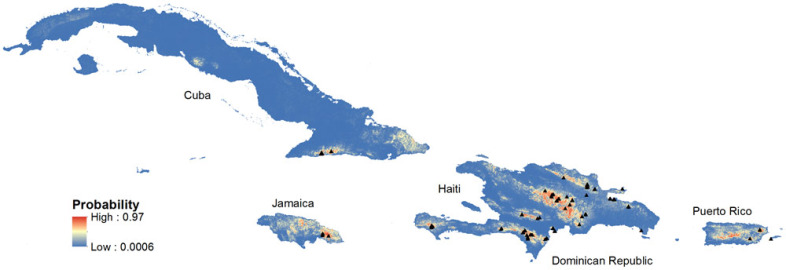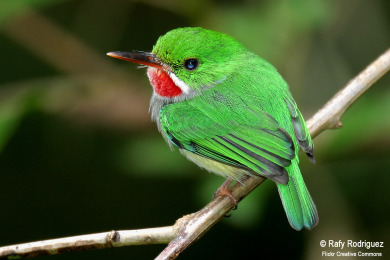
VCE has known for years that Hispaniola is the winter epicenter for Bicknell’s Thrush. We estimate that 80 to 90% of the songbird’s global population packs itself into the island’s dwindling broadleaf forests for six to seven months each winter.
Our evidence comes from field work and intuition. First, surveys by VCE staff and our partners in Haiti and the Dominican Republic have found the thrush in more occupied sites and in higher densities than on any of the three other islands where the songbird is known to winter: Cuba, Jamaica, and Puerto Rico. Second, Hispaniola has far more extensive high-elevation, wet broadleaf forests, which Bicknell’s Thrushes prefer over other forest types.
However, new computer modeling led by VCE Conservation Biologist Kent McFarland has us rethinking Puerto Rico’s potential for Bicknell’s Thrush wintering habitat. The model is designed to identify possible wintering populations we may have overlooked. With the model as our guide, VCE will begin survey work for Bicknell’s Thrush and other songbirds in Puerto Rico in January.

Puerto Rican Tody
Along with experienced local ornithologists and volunteers from conservation groups like the Puerto Rican Ornithological Society, we will conduct targeted surveys across the entire island, focusing on the central highlands. Our primary goal will be to document the distribution, relative abundance, and habitat use of Bicknell’s Thrush, but we’ll also keep close track of other North American migrants and any resident species we encounter.
Like Hispaniola, Puerto Rico supports high levels of endemism, with no fewer than 17 endemic birds alone. Many of these, such as the Puerto Rican Tody, inhabit wet forests at higher elevations.
Our field work will be guided in part by the computer model. Based on what we know about Bicknell’s Thrush distribution, the model determined that five variables — forest cover, winter precipitation, aspect, slope, and elevation — were the most reliable predictors of Bicknell’s Thrush winter habitat. Plugging these into regional land cover data sets, we were surprised to learn that each of the four islands supports extensive areas of moderately wet broadleaf forest that have never been surveyed for Bicknell’s Thrush!
Sixty-two percent of this potential habitat rangewide occurs on Hispaniola (52% in the Dominican Republic and 11% in Haiti), confirming the island’s critical importance as the species’ winter stronghold. But 10% of the habitat is found on U.S. soil in Puerto Rico. Yet, surveys conducted by local collaborators in 1996 documented only three Bicknell’s Thrushes at 242 points surveyed in Puerto Rico’s eastern Luquillo mountain range. Moreover, a large block of wet forest in the island’s central range, the Cordillera Central, which had never been surveyed, stood out like a beacon on our map of suitable habitat (pictured above).
I’ll be heading to Puerto Rico in January to jump-start the field work. We have little idea what to expect from this study, other than the inevitable surprises that Bicknell’s Thrush will surely provide. Regardless of our exact findings, we’ll obtain crucial information to prioritize and direct both local and range-wide conservation planning for this species and its vulnerable winter habitats. We know that effective conservation of forests throughout the Greater Antilles extends far beyond Bicknell’s Thrush to encompass a rich suite of biotic diversity.
Put simply, we can’t fully conserve Bicknell’s Thrush until we explore all its potential winter habitats. Stay tuned for an early-spring update on this new dimension to VCE’s 20 years of work in the Caribbean.

Hey Chris and Kent! That map is a great idea! I wish you lots of luck finding Bicks this winter. I’ll be in a Puerto Rico Jan 1-4 before I go to Dominica to look for Black-capped Petrels with Adam Brown and Environmental Protection in the Caribbean. I’ll play some Bick songs on Dominica and let you know what I find.
Hi Jim, Thanks. The model has been helpful in a variety of ways for sure. Chris went to Dominica to check for BITH a bunch of years ago as someone thought they heard them there. It turned out a common species there has a call similar to BITH. He found none. But, always worth a shot. Have a safe trip. Hope to catch up with you one of these days.
Thanks Kent for the good work. I would be interested to receive the ArcGIS shapefiles to share with the Parc National Naturel Macaya in Haiti.
Hi Joel, do you mean the shapefile of BITH modeled habitat in Caribbean? You can get a KMZ here: http://bicknellsthrush.org/winter.html. I can send you an ESRI GRID if you want that too.